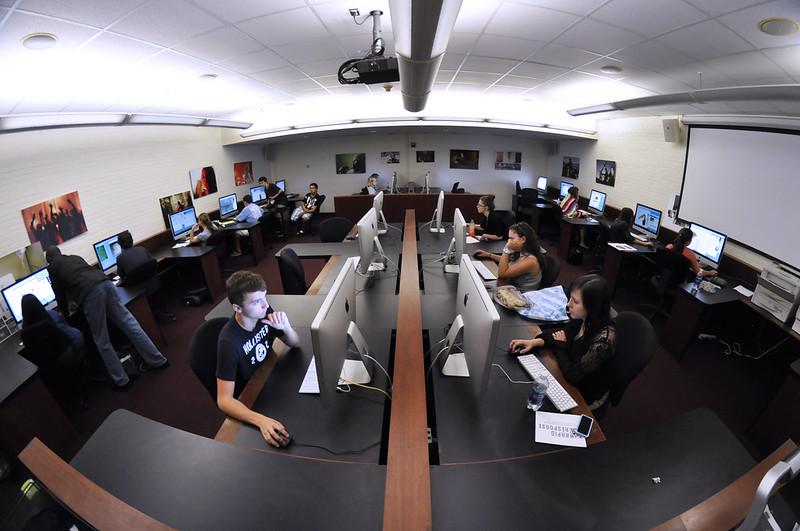If you are considering pursuing a career in desktop publishing, this advantages and disadvantages list will help you make the right choice.
I will analyze these aspects based on my many years of experience working in this field. Let’s dive into this post to discover now!
Overview
A desktop publisher, often called a DTP expert, is someone who designs and arranges printed and digital materials (brochures, magazines, flyers, etc.).
They use specialized software and computer tools, such as Adobe InDesign, QuarkXPress, and Adobe Illustrator, to do their tasks. Here’s what they do:
- Ensure text, pictures, and graphics look good on a page or screen.
- Ensure the words look neat and use the right fonts and sizes.
- Edit and improve images to make them better.
- Get files ready for printing or sharing online so they work correctly.
- (Sometimes) create or change images and drawings to match the content.
- Check for spelling, grammar, and layout errors.
- Work with writers, editors, photographers, and clients.
These skills are in demand across various sectors, including advertising, publishing, marketing, and corporate communications.

My following sharing about the ups and downs of being a desktop publisher will make it easier for you to consider pursuing this career. Let’s check!
Let’s begin with the pros of working as a desktop publisher, including creative freedom, not requiring complex technical skills, opportunities to work on various projects, and accessible tools!
1. Creative Freedom
What makes being a desktop publisher super cool is I get to be creative. I can play around with different styles, colors, and pictures to make things look awesome.
I’m like an artist, but I use a computer screen as my canvas. I can design all sorts of stuff, from fancy wedding invitations to exciting brochures and even e-books. Each project is a new adventure, and I get to try out different ideas and styles.

2. Does Not Require Many Complex Skills
Working in desktop publishing, I don’t need to be a computer genius to do my job well. While I use special software, it’s not as challenging as coding or programming. I believe you can learn the basics quickly.
The best part is that I don’t have to be a design prodigy. Of course, some artistic flair helps, but I can follow templates and guidelines to create attractive layouts. It’s more about making things look good rather than being a Picasso.
And I don’t need to be a grammar guru. While proofreading is vital, I’m not expected to be an English professor. I just need an eye for catching the mistakes.
So, being a desktop publisher is accessible. It’s about combining some computer skills, basic design sense, and attention to detail, making it a career that’s within reach for many.

3. Wide Range of Project
Another thing I like about this job is I get to work on various projects, including magazines, brochures, newsletters, websites, etc.
Today, I am making a professional-looking annual report for a company. But tomorrow, I may design a colorful poster for a local event.
What’s great is that I can also work in many fields (fashion, tech, finance, education, etc.). So, I’m always learning and coming up with fresh ideas.
4. Accessible Tools
Being a desktop publisher is made even better by the accessible tools at my disposal. I just need a computer and some software.
The tools I use, like Adobe InDesign and Microsoft Publisher, are designed to be user-friendly. It’s not overly complicated, and I could learn them pretty quickly in the early days of pursuing this career. Many online tutorials and help resources are also available if I get stuck.
Plus, I don’t need a super expensive computer setup. Any decent computer can handle the software, so I don’t have to break the bank to get started. This accessibility means that almost anyone can give desktop publishing a shot.

If you want a career in desktop publishing, there are three drawbacks you need to consider: not-so-great salary, shrinking demand, and long-hour working.
5. Low Salary
One downside of this job is that it doesn’t pay a lot. On average, a desktop publisher in the US makes around $54,920 a year. This salary is lower than the average salary nationwide in the US at $59,428 per year.
6. Declining Demand
Another problem is that there aren’t as many jobs for desktop publishers as there used to be. The number of jobs in this field can drop by 13% from 2022-2032 because computers and software can do some of the work now, and more people can make their own products.
7. Require Working More Than 40 Hours/Week
In this role, I often work more than 40 hours/week because there are often tight deadlines for projects, and I usually juggle multiple tasks at once.
While I enjoy creating designs and layouts, the pressure to finish projects quickly sometimes makes me feel stressed. Plus, when I’m in a rush, I do not have as much time to check and improve my work, affecting its quality.

How To Know A Career In Desktop Publishing Is For You?
A career in desktop publishing is your thing if you love designing, working with computers, paying attention to details, and don’t mind learning new computer tools.
But there are a few things to consider. The pay might not be as high as expected, and there might not be many job openings. Also, you might sometimes have to work extra hours to finish projects on time.
So, consider the challenges and see if you are willing to sacrifice them to work in this field!
Conclusion
Now you know the pros and cons of being a desktop publisher. It is evident that desktop publishing offers opportunities to unleash creativity, hone technical skills, and contribute to effective communication.
However, when entering this field, you should consider the potential drawbacks, such as a relatively lower salary, declining demand, and long working hours.
Thank you for reading!
